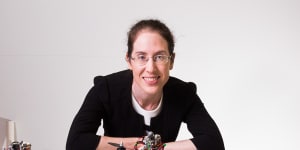
Rocket scientist Airlie Chapman says a common theme in her research is working with many small things that,together,accomplish big things.Supplied
8:30am: My day starts with some solo reading time on the latest paper draft from the lab and new research in the field of space and robotics. There’s more out there than you can consume:I recently enjoyed exploring a paper on safe operation of swarm robotics – many robots working together.
9:30am:I meet with one of my PhD[students],Rob Mearns,and catch up on his innovations in satellite communications. Traditionally,small satellites can traditionally only communicate twice a day with a ground station – he’s trying to use existing satellite communications networks to communicate outside those precious windows.
10.15am: Today,my next meeting at MSL is with my research engineer,Clint Therakam,to discuss his work on the thermal analysis of the new Australian moon rover prototype (the “Roover”). The moon experiences extreme swings in temperature so keeping the rover at a nominal temperature is critical to keeping it operational.
11am: Next is a strategy meeting with the MSL team to go over the latest satellite telemetry from the SpIRIT satellite. It’s a shoebox-sized satellite that launched in December. SpIRIT weighs just 11.5 kilograms and is part of an Australia-Italy partnership.
A common theme through my research as an aerospace and robotics engineer is that I work with many small things that,together,accomplish big things. Small satellites that punch above their weight are a good example.
When you start making things small you get plenty of extra challenges,but if something goes wrong you haven’t put all your eggs into this one massive satellite basket. As a more cost-effective option,it also puts space in arms reach for many nations.
SpIRIT is going to end up being a part of a constellation of seven satellites which are going to work together to detect far-off gamma ray bursts – some of the most powerful explosions in the universe. We are in the commissioning stage,so we discuss the current priority list for the subsystems’ operations.
1:15pm:After a quick lunch,I head to the VCA (Victorian College of the Arts) to meet with our gallery robotics team about the current interactive swarm robotics installation we are running. We discuss the current state of the robots,maintenance and repair schedule,as well as the human survey results.
3pm: Still at the VCA,I provide a demonstration to the visiting National Gallery of Victoria curators showcasing the newest robotic installation and discussing their thoughts. The installation is interdisciplinary – a combination of theatre,arts,robotics and archaeology – so people are interested in how the concept emerged and evolved,and in getting under the hood.
Most people don’t interact directly with cutting-edge robotics,so exhibits like this encourage people to learn more about technology. It makes it approachable,and hopefully gets people a bit more excited about STEM innovation. Maybe it even excites the next generation of engineers and scientists.
4pm: After jointly meeting with the gallery’s artist and robotics teams to discuss scaling up the number of humans and robots in the gallery space,I head back to my University of Melbourne office. I need to catch up on student emails and provide directions and approvals to students in my role as the Mechatronics Program Coordinator.
9pm: We’re a global network of people,so I often have international calls,although the UK time zone is usually the hardest for Australia. Tonight is a quick call with collaborators at the University of Birmingham to discuss work on wide-area mapping with aerial swarms. In this particular collaboration we have two PhDs involved,so these calls will happen at least once a week.
The Business Briefing newsletter delivers major stories,exclusive coverage and expert opinion..